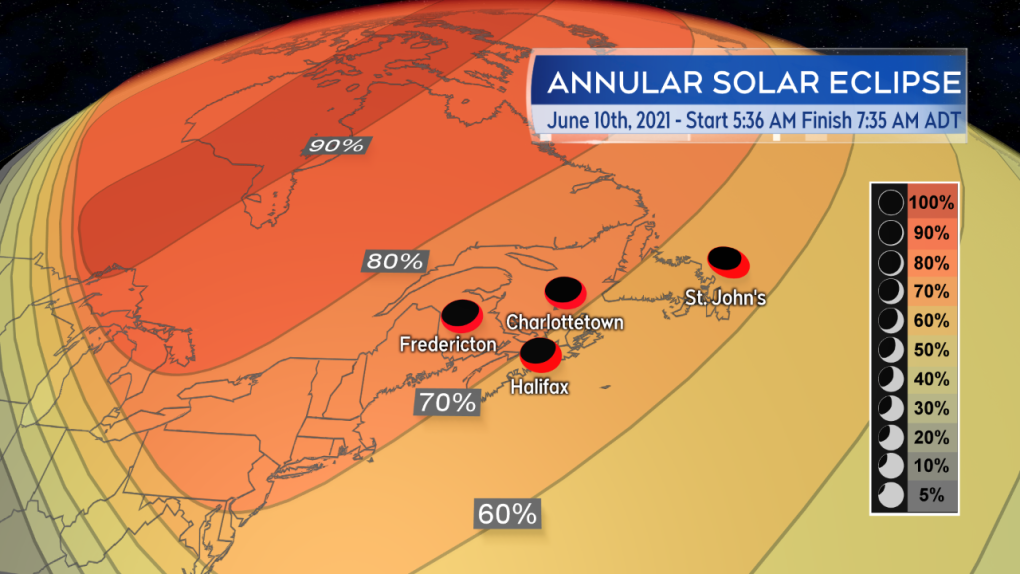Favourable weather on the horizon in the Maritimes for Thursday's rare annular solar eclipse
 Viewing parties were held across the Maritimes to take in the partial eclipse.
Viewing parties were held across the Maritimes to take in the partial eclipse.
The weather in the Maritimes, for the most part, will cooperate for viewing of the annular solar eclipse Thursday morning.
The clearest conditions in the morning are expected to be in the western areas of New Brunswick and Nova Scotia with minimal or thin, high cloud.
Viewing may be more obstructed on Prince Edward Island and eastern areas of Nova Scotia including the North Shore of the mainland and Cape Breton.
There, partly cloudy conditions and a chance of showers are forecast. Remember, the event takes place shortly after sunrise so it will be towards the eastern horizon.
Cooler temperatures and a gusty northerly wind are expected Thursday morning, so you may want to have something a little warmer to throw on.
If you don’t have a way to safely view the eclipse (ISO 12312-2 designated glasses, shade 14 welder glass, pinpoint projector) a number of sites plan to live stream video of the event.

A favourable forecast for viewing the annular solar eclipse Thursday morning. Possible obstruction of partly cloudy skies and showers for P.E.I and eastern Nova Scotia.
The event is an annular eclipse, and not total, as the moon is at its furthest orbital point from Earth so the shadow cast is not enough to completely eclipse the sun.
The event is sometimes known as a "ring of fire" eclipse because of this. The Maritimes is not in the path of totality for this eclipse so we will be limited to a partial eclipse of 60 to 70 per cent. The next total eclipse for North America will be on April 8, 2024 with the Maritime region in the path of totality for that event.

A partial solar eclipse will be viewable in the Maritimes at dawn on Thursday, June 10.
The annular eclipse begins at dawn for our region. For Halifax, it starts at 5:36 a.m., reaches a maximum at 6:33 a.m., and finishes at 7:35 a.m. Those times will vary slightly across the region depending on location. For example moving to Edmundston, N.B., the start is at 5:42 a.m., maximum at 6:39 a.m., and ends at 7:41 a.m. You can search your location or a near by location for timing of the eclipse online.
Like any solar eclipse, the event should not be viewed with the naked eye or with viewing glasses that are not compliant with the ISO 12312-2 international safety standard. Doing so risks permanent damage to the eyes that could include blindness. You can find solar eclipse safety information from NASA.
You can build your own pinpoint viewing projector to watch the event. The government of Canada has a good guide available online, but I'm sure a quick google search would turn up several guides on how to construct and use one.

As always, viewing conditions will be weather dependent. As it stands, the outlook for next Thursday is for partly cloudy skies and a low chance of showers.
Background
This story was updated on June 9, 2021 to include the weather forecast for the event.
CTVNews.ca Top Stories

Donald Trump says Canada becoming 51st U.S. state is 'a great idea.' Jean Charest calls the comment a 'wake-up call'
U.S. President-elect Donald Trump is taking aim at Canada once more, saying it would be 'a great idea' to make it America's ‘51st state.'
'You're either with Beijing or you're with Washington': Ford says to Mexico in CNN interview
Ontario Premier Doug Ford has a message for Mexico as the threat of tariffs by incoming president Donald Trump hangs over both sides of the U.S. border.
There are 88 new Order of Canada appointees. Here's a look at some of the most notable names
Ryan Reynolds, Scott Oake and Maureen Ann Jennings are among the 88 new recipients of the Order of Canada.
NEW Here's how the cost of living challenges are shaking up Canadian seniors' retirement plans
With the high cost of living increasingly a concern, some seniors are making sacrifices to help their adult children and grandchildren make ends meet. Here are some of their stories.
'Why would I box myself in?: Singh on why he won't commit to helping bring Trudeau's gov't down, yet
NDP Leader Jagmeet Singh says U.S. president-elect Donald Trump's looming tariff threat is part of the reason why he's not committing to voting non-confidence in Prime Minister Justin Trudeau's government.
Iconic Halifax ship Theodore Too partially sunk at Ontario dock
An iconic ship that was a fixture in Halifax Harbour for 21 years has partially sunk in Ontario.
Oscars shortlist revealed. See which movies made the cut
A shortlist of Oscar contenders in ten categories has been revealed.
Canada Post provides update on Santa letters
Canada Post provided an update Wednesday about letters addressed to Santa, reassuring children that their letters will be delivered to the North Pole by Christmas Eve. However, Santa won't have time to respond to them.
Thousands of toddler step stools recalled after child's head gets stuck
Thousands of toddler step stools are being recalled after a child's head got stuck in one.

































